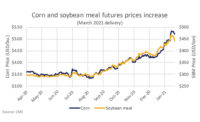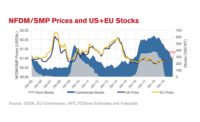The Chicago Mercantile corn contract traded over $7.00 the first week of May, which is the first time we’ve seen that since 2013. Dairy futures, and maybe even spot prices, have been pulled higher by the increasing feed prices. I think it’s worthwhile to think through exactly how higher feed costs affect spot dairy prices, dairy futures prices and the lags involved, and also what we should expect for the magnitude of dairy price changes.
Spot prices
It will take anywhere from one to six months for the higher feed costs to actually start to show up in the cost of dairy farmers’ rations. Farmers may have feed costs locked in, or they may grow the majority of their own feed and will be insulated from the higher input costs for a while. Eventually, the higher feed costs will slow milk production growth, and dairy prices will end up being higher than they would have been if feed costs were lower.
I’m hesitant to say the higher feed prices will cause dairy prices to rise, because that will be dependent on demand. If you think the price is going to be higher in the future, you may buy spot supplies right now to hedge against those higher prices in the future, and that could push spot prices higher. This only works for storable commodities (think butter/powder). It should have less of an impact on cheese.
Dairy futures
The dairy market typically recognizes that most of the impact will be felt in the future, and we tend to see deferred dairy contracts increase (or decrease) along with large moves in feed prices. The strongest correlation between the nearby price of corn and Class III milk futures is at six to eight months into the future. So statistically, the move higher in May corn should impact the October-through-December Class III futures the most.
Magnitude of impact
The historical relationship among nearby corn, spot cheese, spot dry whey and the Class III curve would suggest that the Class III futures from May through December should currently average $18.49, but the futures are currently trading well above that — with an average of $19.30.
Another way to look at the magnitude of impact is to look at the cost of production for dairy farmers. This is fraught with all kinds of theoretical and practical issues. But if we assume that demand is growing a little bit each year, then, on average, the market needs to pay the cost of production plus a little extra to encourage farmers to continue to expand milk production.
With $7.00 corn, a large, efficient U.S. dairy farm likely needs a Class III price around $17.30 to break even. Again, the Class III futures for the next 8 months average $19.30, which is well above the cost of production.
The impact of higher feed costs will be felt in other major dairy exporting countries as well. While dairy farmers in Europe and Argentina are statistically less sensitive to feed costs than U.S. farmers are, the higher feed costs have shifted their milk production forecasts a little lower, too. The tighter expected milk supply, along with very good Chinese demand, has pushed our dairy price forecasts higher.
I am confident that higher feed costs will raise dairy prices higher than they otherwise would have been — with most of the impact happening about six to 12 months in the future. However, it looks like the futures already have this priced in, with some added risk premium on top. Milk futures are above the cost of production and higher than what you would expect given the historical relationship between spot/feed prices and the forward curve.
.jpg?1623938483)


